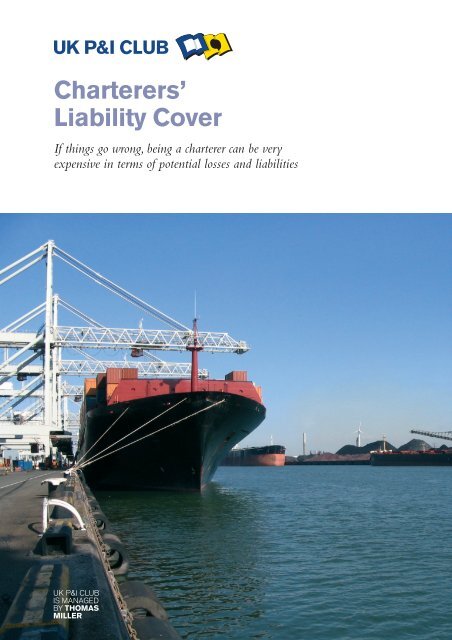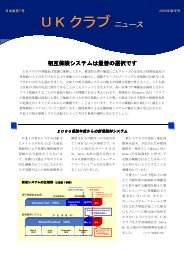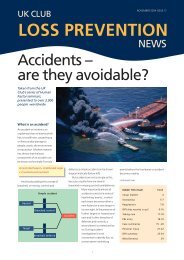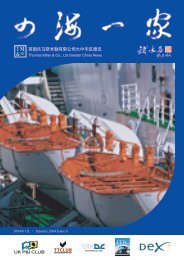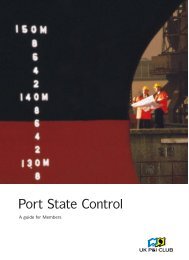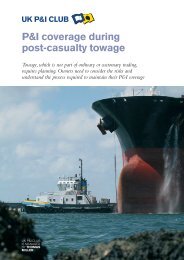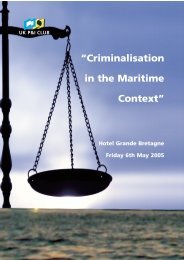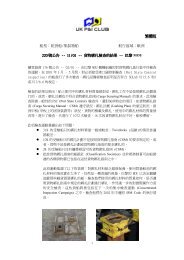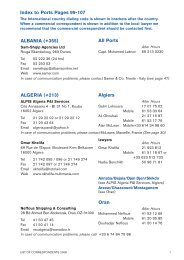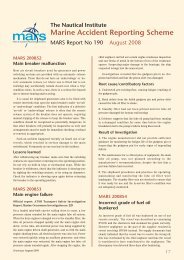Charterers' Liability Cover - UK P&I Members Area
Charterers' Liability Cover - UK P&I Members Area
Charterers' Liability Cover - UK P&I Members Area
Create successful ePaper yourself
Turn your PDF publications into a flip-book with our unique Google optimized e-Paper software.
Charterers’<strong>Liability</strong> <strong>Cover</strong>If things go wrong, being a charterer can be veryexpensive in terms of potential losses and liabilities
2Charterers’ <strong>Liability</strong> <strong>Cover</strong>Risk is increasing, and not only because of aggregations of value carriedon ever larger ships, and increasing commodity prices.The regulatory environment underpins claimsinflation and will look at all connected parties inthe event of a serious shipping accident, not justthe shipowner.You may be a slot, space, voyage or time charterer.You may be a traditional chart-erer with a shipoperating background, or a trading company movingraw materials or finished product, or a trader buyingand selling on a scale that requires chartering.Whichever you are, you will find what you needin <strong>UK</strong> Club’s Charterers’ <strong>Liability</strong> <strong>Cover</strong> facility,which can be adapted to meet your exact needs.You certainly need insurance. It may be that thetraditional product meets your needs well – and itremains available. However, increasingly charterersare seeking something specifically tailored to theirparticular situation – in which case the flexibilityof our new product can provide what you need.• Tailored package of cover and premium• Integrates with hull and other covers• Pure liability protection for non-operationalcharterers• Pollution liability without sub-limit• Most extensive network support• Minimise delay due to arrest/detention• Responds to continual changes in charter fleet• Minimises administrative burdenWhy a <strong>UK</strong> Club cover?Financial security and service are the twin pillars upon which the <strong>UK</strong>Club bases all its activities. The cover and service provided to thecharterer member is no exception.The <strong>UK</strong> Club’s strength as the world's largest P&Iclub enables it to negotiate covers offering greaterscope and limit, and deliver them for a morecompetitive and stable price than charterers mightachieve individually.The resources and economies of scale that the <strong>UK</strong>Club enjoys as the world’s largest mutual P&Iinsurer confer considerable benefits on its ownedand chartered <strong>Members</strong> including:ClaimsAs a mutual, the Club takes a positive, co-operativeattitude towards its <strong>Members</strong>’ claims. The widespread of international offices and staff makes itsensitive to the needs of different regional andtrade areas.Genuine 24 hours claims handling responseThe <strong>UK</strong> Club possesses the largest internationaloffice network in the P&I industry. Offices inNew Jersey, San Francisco, London, Piraeus,Singapore, Hong Kong, Beijing, Shanghai andTokyo are manned by dedicated <strong>UK</strong> Club serviceteams. Recruited from a variety of operational,legal and technical backgrounds, they combinein-depth expertise with awareness of commercialrealities – to advise on shipping, liability andinsurance issues.An unrivalled online claims support serviceInnovative web-based technology, including our“ClaimsTrac” system, allows you to access andanalyse your claims data and loss record at yourconvenience – day or night.Commercial underwritingThe <strong>UK</strong> P&I Club takes a flexible, individualapproach to cover for all <strong>Members</strong>. Many of itsunderwriters have been longstanding specialists in
3particular sectors or geographical regions.Financial securityThe <strong>UK</strong> Club’s considerable reserves, prudentreserving policy and comprehensive reinsuranceprotection provide great financial security. TheClub has maintained a Standard and Poors ratingat the highest level of any P&I club since thatagency began reporting on the mutual P&Iindustry.Flexible and innovative serviceThe <strong>UK</strong> P&I Club continues to pioneer manynew service initiatives such as its “value formoney” system, managing the performance andcosts of all parties in the claims process. Increasedrecent exposure of ship operators to criminalliability and media attention has been met withmore developed specialist expertise andrelationships with the relevant agencies.Loss prevention and adviceThe <strong>UK</strong> P&I Club is committed to safety. Itshigh-level loss prevention programme – the mostextensive in the industry – aims to offset risingclaims and maintain quality amongst <strong>Members</strong>.Flexible Charterers’ P&I <strong>Cover</strong><strong>UK</strong> Club charterers’ liability insurance providesthe benefit of access to the broad cover describedwithin the Club’s Rules. However, the uniqueposition of the charterer in the maritime industryrequires an enhanced and tailored cover to ensurethat those exposures which go beyond those of theconventional owner-operator are addressed andfinancially secured.Comprehensive cover with high limits at acompetitive pricesThe flexible charterers’ cover offers variable limitsof cover up to US$750 million any one accidentor occurrence.No sub-limit for pollutionThere are no sub-limits imposed below the overallagreed limit of the cover for either pollution risksor other exposures arising from the ship ownerslimitation clause.Integrates with hull and other coversThe flexible charterers cover is designed to becombined with the Damage to Hull cover as wellas other risks (see below)Pollution liability cover for charterer’sown cargo<strong>Cover</strong> can be extended to include cargo owner’spollution liability where the charterer or anaffiliated/associated company is also the cargo owner.Pure liability protection for non-operationalcharterers<strong>Cover</strong> can also be extended to include the<strong>Members</strong>’ legal liability as cargo owners and/orshippers where no charterers interest in thecarrying vessel exists.Flexible range of additional tailored coversMany operators require additional specialist risksto be included to reflect the particular hazardsfaced by their sector or trading pattern. A reviewof some of the key additional covers can be foundon the back page of this brochure.Damage to HullAll risks cover for charterers’ ships<strong>Cover</strong> extends to include financial loss, liability,costs or expenses arising as a direct consequence ofloss of, or damage to, the entered ship.Associated costs and expensesSue and labour and legal costs in accordance withthe cover provided under the flexible charterersliability cover.General average and salvage exposure<strong>Cover</strong> includes the charterer’s general average andsalvage contributions and salvage charges inrespect of loss of or damage to the entered ship,charterer’s bunkers on board and the freight at riskin relation to the ship.High limits of coverThe flexible charterers’ cover offers variable limitsof cover up to US$750 million on any oneaccident or occurrence. To obtain the full limit ofUS$750 million, cover must be purchased on acombined basis.War RisksStandard cover includes War Risks on a worldwidetrading basis.Additional coversA charterer often requires protection for loss of ordamage to his bunkers arising from an incidentinvolving his ship (see back page for additionalcovers).
4What are the key charterers’ risks?Dr Chao Wu, Legal Director of Thomas Miller P&I Ltd explains thekey risks to which a charterer is most commonly exposed and for whichcover is available.P&IA charterer needs standard P&I cover under theRules for the same risks as are usually insured byan owner – and will therefore have cover for hisdirect liabilities to third parties in respect of risksset out in Rule 2. A charterer may need to widenthe scope of cover for direct liabilities if he agreesto take on contractual risks that would not fall tohim as a matter of law (I).However, a Charterer also needs cover for liabilityto indemnify the owner for such risks, set out inRule 2 (II).Let us look at each in turn.Charterer’s direct liability tothird partiesThis can arise either in contract or in tort, as inthe examples below.CargoA charterer will be liable directly to the owner ofdamaged or lost cargo when he is the carrierunder his own bill of lading, or, as may happen insome jurisdictions, if he is considered to be thecarrier under an owner’s bill of lading. Lesscommonly, a charterer may face a claim in tortwhere the carriage contract is with the shipowner,especially if the claim is unsecured and theprospects of recovery from the owner areuncertain.Extended Cargo <strong>Cover</strong>A charterer may need an extension to the scope ofhis direct P&I cover. He may for example enterinto cargo service contracts that are more onerousthan the Club’s standard terms, Hague-Visby. Hemay need cover for geographical or contractualdeviations, such as dry docking with cargo on board.This extended scope of P&I can also respond toclaims arising from the delivery of cargo withoutthe production of an original bill of lading providedthe charterer has taken a letter of indemnity onthe standard form of wording recommended bythe International Group. The policy can also coverclaims arising from delivery at a port other thanthat mentioned in the bill of lading, ad valorembills of lading, rare and valuable cargo, andliabilities arising from unreasonable periods ofstorage. There is a US$50 million limit on coveralthough more is available if required. The policyexcludes inherent vice, delay and loss of market.This extended cargo cover is of course not justavailable to charterers but is also available to shipowner <strong>Members</strong>.PollutionIn certain jurisdictions e.g. California, Alaska &Japan, a charterer can incur direct and even strictliability for pollution caused by the ship. This mayarise in a variety of ways.First, by force of law due to the vessel’s operations.For instance, in the United States Oil PollutionAct 1990 (OPA 90) provides that “any personowning, operating or demise chartering the vessel”may be liable. Although under OPA 90 it seemsthat a time charterer is only liable if considered tobe the operator of the vessel as well, the individualstates in the US have been able to enact their ownlegislation and most states target, “transporter ofoil”, “person having control over oil”, “persontaking responsibility” so that a time charterer canbe at risk. Additionally, in some states such asAlaska, strict liability for pollution is also imposedon cargo interests, so that a charterer who ownscargo attracts liability through that route.Third PartiesA charterer may incur liability directly to astevedore, or any third party, who suffers personalinjury or property damage as a result of thecharterer’s negligence. How might such claimsarise against the charterer? One example would bethe improper description of noxious cargo,resulting in injury being caused to an unprotectedstevedore. Another would be a negligent orderresulting in injury to a longshoreman. In some UScircuits, the NYPE clause 8 has been held to shift
5responsibility for negligence, during loading/discharging from the owner to the charterer.FinesA charterer, if falling into the definition of“carrier”, can be subject to fines e.g. if in noncompliancewith the US “Automated ManifestSystem” Regulations (see Club Circular Ref10/04). Guidance by the US Customs & BorderPatrol (CBP) advised that it views the carrier asthe entity that “controls” the vessel which includes:(a) determining ports of call; (b) controllingloading and discharging cargo; (c) knowledge ofcargo information; (d) issuing of bills of lading; and(e) the entity which has typically provided the CF1302 cargo declaration or the cargo informationto prepare the CF 1302 to the vessel agent.Indemnification of ownersA charterer will have an obligation to indemnifythe owner for third party liability where thisresults from a breach of the charterparty by thecharterer, or arises out of activities which are thecharterer’s responsibility.Typical examples of situations where charterersmay have to indemnify owners for P&I liabilityinclude the following.Unsafe portMost charterparties have a safe port or berthwarranty. Sending the ship to an unsafe port inbreach of that warranty could result in P&Iliabilities such as cargo loss or damage, personalinjury, pollution, or even wreck removal.CrewA charterer will rarely be liable for the owner’screw, but may be responsible to indemnify theowner for liabilities towards stevedores and othersuch personnel.Dangerous goodsThe charterer will be liable to indemnify theowner for any property damage or personal injuryarising from loading or carriage of dangerouscargo. If, as happens with increasing frequency,such cargo has not been properly declared by theshipper, the charterer will nevertheless remainliable to the owner for the consequences. Suchconsequences can be severe and can extend tocargo damage, death or personal injury, pollution,or wreck removal.Stowage incidentsUnder the unamended NYPE clause 8, thecharterer is responsible for loading, stowage, etc. Ifas a result of a collapse of stow due to bad stowage,property damage or personal injury is caused, thecharterer will be liable to indemnify the owner forsuch damage or injury.Bunker qualityIn most time charterparties, the charterer shouldsupply bunkers to the vessel meeting agreedspecifications. He will have to indemnify theowner for any damages resulting from the supplyof off-specification bunkers.
6Stevedores<strong>Liability</strong> for damage caused to the ship bystevedores. Most time charters, particularly in thebulk and general cargo trades, have a stevedoredamage clause, which will make the chartererliable, in certain circumstances, for stevedoredamage.Safe port<strong>Liability</strong> for damage to the ship arising from thefailure to provide a safe port or berth.Marpol Annex VI has introduced restrictions onthe sulphur content of fuel. As a result, a chartererwill now have to supply bunkers not only of aquality to meet charterparty specifications, but alsoto enable the vessel to meet particular portrequirements depending on whether or not thestate has ratified Annex VI. Failure to do so mayresult in the charterer having to indemnify theowner for any resulting loss or liability – whichcould include liability for fines.Poor stowageDamage to the ship resulting from stowagecontrary to the terms of the charter party, wherethe charterer is responsible for loading andstowage of cargo.Hazardous or dangerous cargoDamage to the ship caused by the nature of thecargo itself, such as where cargoes are corrosive orexplosive.For example, BIMCO’s “Fuel Sulphur ContentClause for Time Charter Parties” provides for thecharterer to indemnify the owner for loss orliability arising from a failure to “permit the Vessel,at all times, to meet the maximum sulphur contentrequirements of any emission control zone whenthe Vessel is trading within that zone.”PollutionAlthough most states outside the USA are party tothe CLC (Civil <strong>Liability</strong> Convention) underwhich tanker pollution claims are channeled solelyto the registered shipowner, if the cause of thepollution is something for which the charterer isresponsible (such as in an unsafe port situation)then the charterer may be obliged to indemnifythe shipowner.Damage to HullThe standard P&I cover that is provided toshipowners excludes cover for damage to theentered ship. However, for the charterer, suchcover can be important because of the variety ofways in which a charterer may become liable fordamage to a ship. Many of the above examples ofsituations which might give rise to traditional P&Iliabilities are also situations where the charteredship may be damaged and the costs thereof may berecoverable from the charterer.Bunker qualityDamage to ship’s engines if inferior bunkers havebeen provided by the charterer. Off-spec bunkerscan cause damage to the ship’s main and auxiliaryengines, aside from many other difficulties such asthat of finding a place to discharge off-spec fuel,diverting for new bunkers, and losses resultingfrom slow speeding where this is necessary.General average and salvage liabilityGeneral average and salvage contributions in respectof loss or damage to the ship, Member’s freight atrisk or Member’s bunkers on board the ship.
7FD&D risksAs a charterer enjoying thebenefits of our flexible cover, youwill get the legal costs of dealingwith any P&I claim included aspart of the package. However,many charterers will prefer theadded security of cover for freight,delay and demurrage risks(FD&D risks).The additional step of purchasing a cover from the<strong>UK</strong> Defence Club provides protection for legaland other costs of resolving a wide range ofdisputes about uninsured matters. These includedisputes under charterparties on matters such asoff hire, bunker quality, speed and performance,unsafe port or berth, laytime and demurrage.• Prompt legal and practical advice on the meritsof cases• The way cases should be handled and the coursethey should follow• Negotiating with opponents• Finding the best lawyers and experts for each case• Clear, practical communication with you, thelawyers and the experts• Co-ordination of large cases• Monitoring of costs and fees• Advice on drafting documentationThe <strong>UK</strong> Defence Club is the largest organisationof its kind and has access to the same internationalnetwork of correspondents, lawyers and otherexperts as are used by <strong>UK</strong> P&I. The same <strong>UK</strong> P&IClub underwriting contact that provides yourcharterers P&I and hull risks is also able to arrangean entry with the Defence Club to protect thisother important aspect of your exposure. In addition to providing cover, the Defence Cluband its managers offer advice on:Keeping ships on the moveThe <strong>UK</strong> Club provides insurance to around 5,000 charter entries everyyear. These entries have generated an average of 1,700 claims each year,which represents a considerable fund of expertise in this specialist area.The <strong>UK</strong> Club’s network of offices in Europe,Asia-Pacific and the Americas are well placed tosupport them. In turn, that network can call onthe Club’s correspon-dency network of some 350legal, commercial and technical specialists for localsupport in the handling of claims.development of streamlined declaration systems tominimise the administrative burden of obtainingcover for a continually changing charter fleet. As well as direct problem solving expertise, theyprovide the essential support and guarantee systemsthat enable a ship to sail with minimum delay inthe event of arrest or other legal detentions.Minimising delay means minimising costs.The <strong>UK</strong> P&I Club recognises that ease of use isessential for any charterers’ package. The volume ofcharter business handled by the Club has led to the
8Flexible optionsCharterers’ BunkersAs a charterer you risk sustaining your own losseswhere an accident is serious enough to cause lossof the ships bunkers. You may therefore want toinclude in your cover protection for loss of ordamage to charterers’ bunkers reasonably attributableto fire or explosion, stranding, grounding, sinkingor capsizing of the entered ship, or to collision ofthe entered ship with any external object.This cover is based on Institute clauses includingthe relevant Wars and Strikes Clauses and availableup to a limit of US$2 million any accident oroccurrence.Charterers’ FreightThis cover is provided under the Institute Time orVoyage Clauses Freight (1.11.95) for up to US$5million any one accident or occurrence. <strong>Cover</strong> canbe obtained for all risks or as total loss only, butincluding salvage charges and sue and labour.Blocking and TrappingIf a charterer should be caught by a closure orrestriction of navigation within his declaredtrading area, the daily time charter hire paymentscan be recovered under this cover.Passenger Ships Special RisksThe cover available to owner <strong>Members</strong> in respectof additional risks arising from passenger canalso be included in a charterer’s package.Such risks include loss of effects, liabilities topassengers arising away from the ship such asadditional compensation and legal costs.Further information on special passengerrelated risks can be obtained from your normalunderwriting contact.Causes of such delay or detention can includebreakdown of locks or seaway equipment,blockage by sunken or stranded objects or ice, andstrikes or stoppages by any personnel essential tothe transit of a seaway. The cover can also beextended to include additional expenses incurredin re-routing ships to avoid such a delay.Further assistanceThe <strong>UK</strong> P&I Club will be pleased to provide youor your broker with further information on howthe Club’s charterers’ covers can be tailored to thespecific needs of your current charter fleet.Either you or your broker are welcome to contactthe underwriting department in London directly.The direct contact details of all individualunderwriters are listed in the “Making Contact”section of the <strong>UK</strong> P&I Club website –www.ukpandi.com. That website enables you toidentify the individual underwriter specialising inyour particular area.The underwriting department can be contacted byfax at +44 20 7621 9761 or by email atunderwriting.ukclub@thomasmiller.com.Alternatively, the Club’s managers and agents canbe contacted at the numbers provided at the footof this brochure for more information.If you require more general information on the<strong>UK</strong> P&I Club, the Club’s marketing departmentwould welcome your enquiry. Contact NickWhitear (nick.whitear@thomasmiller.com) orJenny Whitehead(jenny.whitehead@thomasmiller.com).Alternatively, the <strong>UK</strong> Club website is anexhaustive source of information on the Club andP&I issues in general.For more information, please contact:Thomas Miller P&I Ltd – LondonTel: +44 20 7283 4646 Fax: +44 20 7283 5614Thomas Miller (Hellas) Ltd – Piraeus H1Tel: +30 210 42 91 200 Fax: +30 210 42 91 207/8Thomas Miller (Americas) Inc – New JerseyTel: +1 201 557 7300 Fax: +1 201 946 0167Thomas Miller (Hong Kong) Ltd – Hong KongTel: + 852 2832 9301 Fax: + 852 2574 5025www.ukpandi.com


